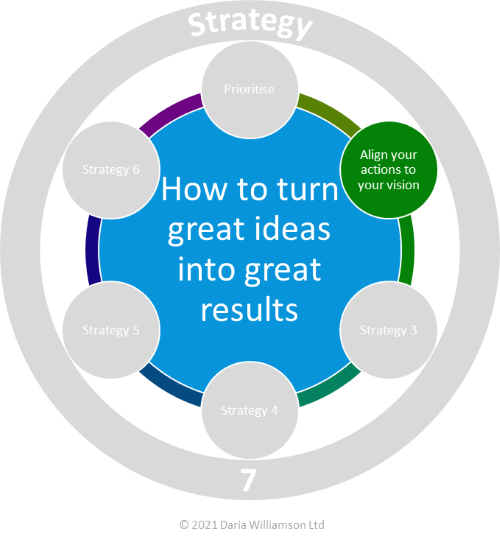Hand-in-hand with prioritising your ideas, it’s vital to align your actions to your vision. When we don’t align things properly, we waste an awful lot of time and energy on ideas that deliver the results we want. There’s no point polishing the silverware if you’re planning to eat with chopsticks!
Every action flows uphill
Everything you do in your daily work flows “uphill” in your team and organisation, influencing the likelihood of achieving the top-line vision, objectives, goals and targets. The work you choose to do will take you closer, or further away, from achieving the top-line stuff.
Smart organisations know to align everyone’s daily work with the organisation’s ultimate purpose. They make the overall vision clear, and ensure that, when objectives, goals and targets are met, the company will be closer to delivering on its vision. If everyone has a straight “line of sight” between what they do, and the organisation’s purpose, there’s a much higher likelihood of success.
How to align your actions to your vision
There are a few steps, each of which is necessary, but not enough on its own, to align your actions to your vision.
They are:
- Clarify your vision
- Identify the key elements you can influence
- Match your great ideas with the elements you can influence
- Generate an action plan
- Implement your action plan
- Check and adjust your implementation
1. Clarify your vision
What is the team, project or organisation trying to achieve? What is its ultimate purpose, and reason for existing?
If you haven’t made this clear, your people will struggle to make good decisions in their work.
A telescope isn’t much help if we don’t know where we’re supposed to aim it. And it’s no good to climb a ladder only to find it leaning against the wrong wall.
Once we know where to put our efforts, we pay attention to the right things, in the right way. And that helps everyone to pull in the same direction.

2. Identify the key elements you can influence
You’re not going to pull down every barrier and solve every problem, no matter how great your ideas. Some realities are fixed, and the sooner we accept this, the sooner we can focus our energies on what we can influence.
What are the biggest barriers to success that you also have some control over? These are the elements to start working with. As you implement your great ideas and get great results, you may find that what was once a fixed barrier is now something you can influence. But don’t be fooled into trying to shift it before it’s ready!
So, make a list of the key elements that you can influence directly. Check that they align with the organisation’s top-line vision, goals, objectives and targets (this is what makes them “key” elements). And then use some of the strategies from my earlier article to help you prioritise these elements for action.
3. Match your ideas to the elements you can influence
Now that you have a prioritised list of key elements you can influence, match them with your prioritised list of great ideas.
The reason I recommend doing this matching exercise after prioritising your great ideas is that it’s always best to start with the lowest-hanging fruit. And what could be better than an easy-to-implement idea, that will have a significant impact on a key element for your organisation? That’s win-win-win!
4. Generate an action plan
This is where the rubber starts to meet the road! You’re ready to identify the steps to move from ideas to results.
This is where some of my favourite coaching questions really shine:
- What’s the smallest concrete step or next right thing to implement each idea?
- What’s will give me the biggest bang for my buck in making this change?
- How can I recruit others to take steps to implement these ideas?
- What does “done” look like?
Build an action plan that includes:
- The specific action to be taken, along with any relevant context or helpful information
- Who is responsible for taking the action
- The due date for the action to be completed
- The feedback mechanism to confirm action completion
Tips for an effective action plan:
- Take care with “all” or “every” in an action, it’s not complete until all and every have been done!
- Each action needs to be verifiable (i.e. you can point to evidence of its completion)
- Start small – instead of “change all widgets out”, start with something like “calculate cost/benefit of changing widgets out”. That way you don’t back yourself into a corner.
- When assigning actions, make sure the person you are assigning it to understands the purpose and reason for the action, and has accepted the action and agreed to the due date. If you skip this, you risk the action not being completed.
- Only have one person responsible per action. If you put two or more people’s names down, no one “owns” the action.
- Set realistic due dates – this is not time to be an optimist! Take into account people’s workload, other demands in the organisation, and “slippage” caused by illness or emergencies. It’s better to finish an action early than to drag one past it’s due date.
5. Implement your action plan
Now you’re underway! Roll out the action plan.
Make sure you’ve got access to the right tools, resources and know-how, and support from people who matter. That’s not just senior leaders, but also the people who will be implementing the change, and who will be affected by and benefit from it.
The implementation phase is where you’ll get a good stress-test of whether you have developed a robust action plan (clear and effective actions, realistic due dates, appropriate action parties). Take note of any issues you encounter, and refer to these when you develop future action plans – that way, you’ll embed the learning and avoid repeating the mistakes!
6. Check and adjust your implementation
There is no such thing as a perfect implementation. You’ll need to check regularly to ensure the implementation is proceeding according to plan, and make adjustments when it goes off-track.
It’s easier to do a 1-degree course-correction now, than a 180-degree turn because you drifted away!
Aligned actions will get you to your vision, eventually
Continous improvement is usually more of a marathon than a sprint. Iteration by iteration, you patiently approach your goal incrementally, taking time to test your theories and ensure they deliver results before moving on to the next thing. It doesn’t mean that you won’t occasionally implement an idea that brings a step-change result. But in general, just like the hare and the tortoise taught us (try saying that five times fast!), slow and steady wins the race.
Ensuring that you align your actions to your vision is a key foundation for this incremental, cumulative approach. That way, each step you take is a step in the right direction.
The next article in this series will help you make those incremental changes – sign up below to my newsletter to be the first in the know when it gets published!
Progress check
This article is part of the series, ‘How to turn great ideas into great results’. The articles so far are:
- Why we struggle to get started
- Strategy 1: prioritise
- Strategy 2: align your actions with your vision (this article)
Stay tuned for the next article covering the third strategy for turning your great ideas into great results. You can keep an eye on the series page for new articles, or sign up to my weekly newsletter below to be the first in the know when a new article is published.
If you’d like to learn more about generating ideas, check out the companion to this series, ‘How to have great ideas‘. It has ten science-backed strategies to help you generate great ideas.





1 thought on “Great results: Strategy 2 – align your actions to your vision”
Pingback: How to turn great ideas into great results: Strategy 3 – experiment ~ Daria Williamson
Comments are closed.